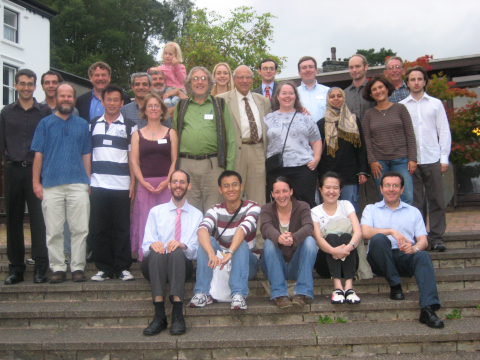Family
Peter Cameron's Blog 2021-01-19
The coincidence of Peter Neumann’s funeral and Eric Lander’s elevation in the last few days has inevitably made me think about family (in the mathematical sense).
First, pictures of my aunts and uncles, brothers and sisters, sons and daughters, taken nearly fifteen years ago at Ambleside in the Lake District.


Families always have hidden secrets, joys and sorrows; but they do matter. Tim Penttila was in love with projective geometry for as long as I knew him; I well remember his delight when he discovered that he was a descendant of Oswald Veblen, a great pioneer in the subject. Henry Whitehead, who said “Combinatorics is the slums of topology” (this was told to me by Graham Higman, his student and my mathematical grandfather), has a fourth-generation descendant who has a doctorate in combinatorics and who became director of the Whitehead Institute.
Incidentally, Peter Neumann told me that Whitehead was not really Veblen’s student, though they worked together very closely. Well, who knows? Even the Mathematical Genealogy Project admits that Lagrange was not really a student of Euler, being self-taught. In his Miscellany, Littlewood credits (I think) Hardy with the observation that a proof of a theorem with a couple of gaps is like being descended from William the Conqueror with a couple of gaps. (So I am descended from Leibniz with possibly a couple of gaps.)
So this is an opportunity to tell briefly something about Eric. He arrived in Oxford on a Rhodes Scholarship to do research in algebraic topology. But before the term started, he had changed his mind and decided to do coding theory instead. By chance, it happened that I was the only person in Oxford at the time who claimed to know anything about coding theory. (I had worked with Jack van Lint, and at the instigation of Dan Hughes had written the book with Jack which in its latest version is Graphs, Codes, Designs and their Links.) So I got to supervise Eric.
As it happened, I had something much vaguer than a conjecture which I thought he might like to think about. I had observed that there were two techniques in design theory which, where they overlapped, gave similar results. One, going back to the Bruck–Ryser and Chowla–Ryser theorems, had been used by Dan Hughes to investigate automorphisms of designs. It applied whenever there was a prime which divided a certain parameter to an odd power. The other was the construction of a self-dual code from a design, which was later crucial in the nonexistence proof of the projective plane of order 10; it required a prime to divide the same parameter to the first power only. I thought there might be a common generalisation, which would extend the power of the first technique and the scope of the second.
Eric, with a good background in algebraic number theory, took to it immediately. The coding theorists had taken an integer matrix and considered its row space over the finite field with p elements. Eric observed that, if instead you took the row space over the p-adic numbers, then you could reduce it modulo arbitrary powers of p, and get a chain of codes, with the property that duality reversed the order in the chain (so if the power of p involved was odd then the code in the middle was self-dual).
Eric’s thesis took off from there, and at the end he turned it into a book with the title Symmetric Designs: An Algebraic Approach. So, when he came to Ambleside to talk at my birthday conference, he called his talk “The Human Genome: An Asymmetric Design”.
This reminds me of another story, which I have probably told before. It is a family failing (and I mean my real family here) that as we get older we forget that we have told stories before and tell them again to the same people.
The American Mathematical Society had (maybe they still do) a slot for a talk at their meeting for somebody who uses mathematics in their work in another area. One year they invited Eric to talk. On the plane, he was sitting next to someone who was obviously a mathematician, so they introduced themselves to each other. Eric’s companion was amazed. “Not the Eric Lander, of Symmetric Designs: An Algebraic Approach?” Eric told me this with great delight.
Now back briefly to Peter Neumann. At his funeral yesterday, Sylvia mentioned his love of music (he played violin and viola). I was transported back to a room at a British Mathematical Colloquium (not sure where or when), where Peter Neumann and Philip Higgins played some of Bartók’s Duos for Violin. I was absolutely spellbound by this beautiful music, and lost no time in finding a copy of the score. I found that it adapts well to the guitar, with no transposition necessary. A few times in my life I have been fortunate to have a guitar player to perform the duets with.